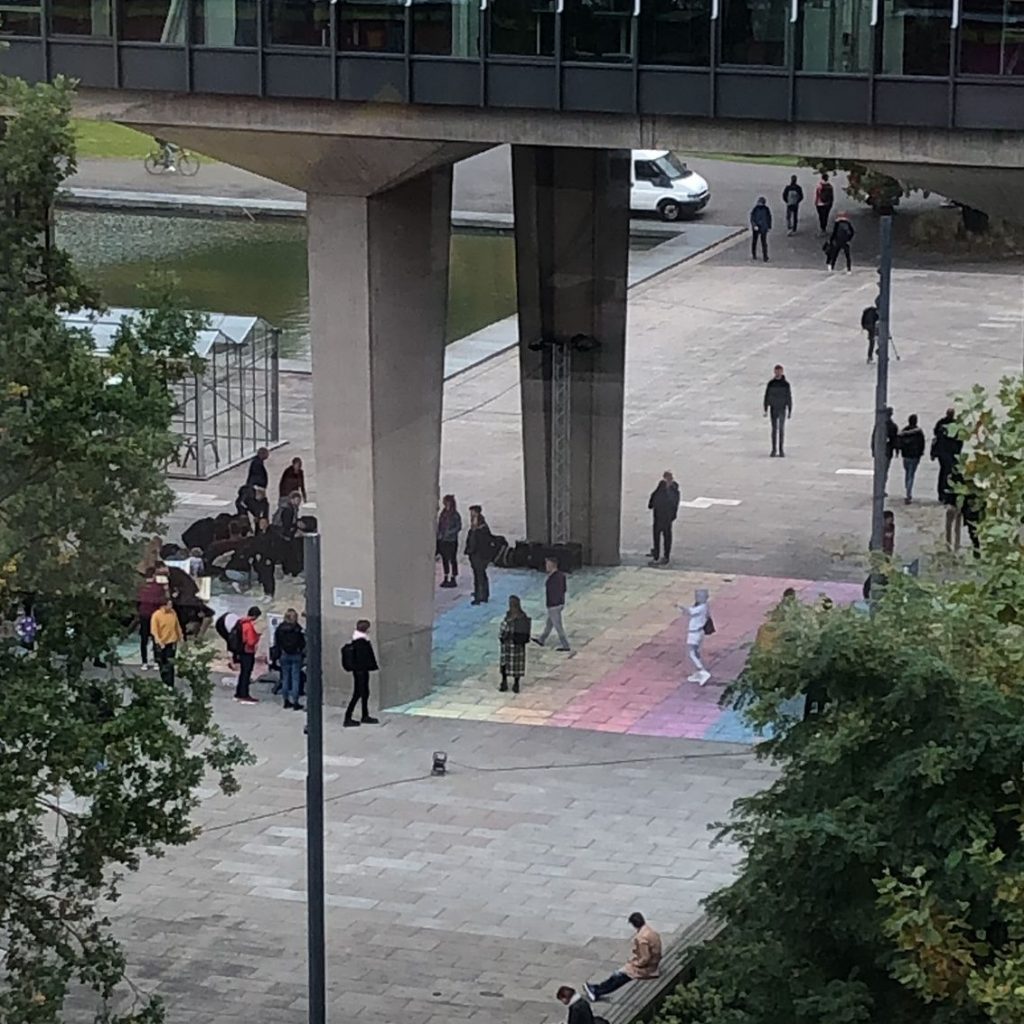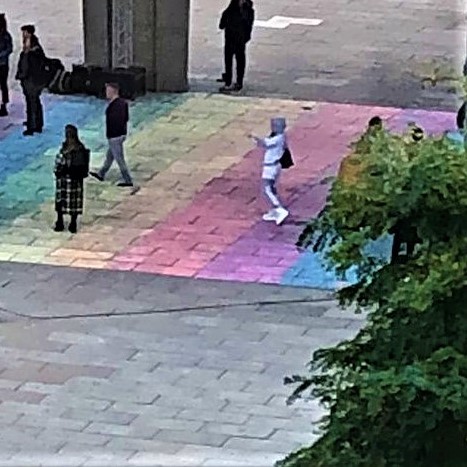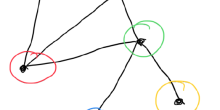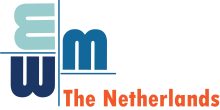Beyond the rainbow crossing: on issues, questions, and opportunities for LGBTQ+ researchers.
In October 2019, the pavement in front of the Atlas building at the Eindhoven University of Technology (TU/e) campus was covered in bright rainbow colors. Not because the TU/e board of directors decided to celebrate diversity in such an explicit way, but because they did the opposite.
Let us go back a week in time. The Cursor (a TU/e news page) reported that Compass, the LGBTQ+ (people that are not hetero-sexual or cis-gendered) association of the TU/e, won a diversity budget for a rainbow crossing path. However, this crossing path was rejected by the quality control commission of the TU/e, stating that it “didn’t fit in the design of the campus”. This statement sparked a small protest amongst students that later colored the entrance with chalk to celebrate diversity.

Rainbow bike lane at the Uithof campus in Utrecht. Taken from the website of Utrecht University.
This controversy, if you wish to call it that, sparked debate within the TU/e and in the cluster I am working in. Some argue that something as visible as a rainbow crossing is key in promoting diversity and can serve as daily reminder of the freedom we have, but some argue that a rainbow crossing does not help or solve problems that LGBTQ+ people face. But, in my opinion, the biggest contribution it made, was the discussion itself – that something simple as the color of a pavement puts such a heavy topic on the table.
This is one of the many benefits from making an LGBTQ+ related statement visible. I would like to use the platform that I was fortunate enough to get from NETWORKS, to share with you the other benefits of visibility and its importance to inclusion and equality for STEM researchers.
Visibility should not only be restricted to the rainbow crossing and everything it stands for, but also to the long, old, and gray pavement after it, that symbolizes the long road ahead for true inclusivity. On surface level it may seem fine, but only when looking closer, the cracks in the foundation start to appear.
Over the years, more researchers have been highlighting these cracks, that unfortunately, still exist to this day. New studies are conducted that keep reporting alarming numbers on the negative workplace experience of LGBTQ+ people in STEM and the consequences thereof. A 2019 study report that amongst physics researchers, 28 percent of LGBTQ+ researchers indicated to consider leaving academia because of the work environment. Recent studies from 2021 and 2022 showed that LGBTQ+ people in STEM (and other underrepresented groups) experience more harassment, fewer career opportunities, feel less social inclusion and earn less. This is paired with an increased percentage of people that suffer from mental problems, as stress and depression. This is especially troubling as it is widely known that diverse groups are stronger. By making these results visible, I hope the research community realizes there is still a lot of fixing to do.
Fixing these cracks, especially in academia, is in my opinion particularly tricky, due to the global aspect of our job. We collaborate with people all over the world but may sometimes forget that people from different places have different experiences or traditions than we do. We also must not forget that not every country is safe for LGBTQ+ people. This was highlighted here where, at the time, the International Congress of Mathematicians, one of the largest mathematics conferences was held in (pre-war) Russia, a country notorious for its controversial anti-LGBTQ+ laws, that have recently been made even more strict. This means that the paths for LGBTQ+ researchers simply do not reach that far. Not only is there an ethical choice to be made whether to go or not, but also one based on their own safety. I experienced a similar awkward moment when I was asked if I wanted to attend a summer school in Hungary, a country with similar anti-LGBTQ+ laws.
On the bright side the number of LGBTQ+ central STEM conferences have significantly increased in last decade which was also noted by Bonato et al. For upcoming researchers that may feel insecure about being an LGTBQ+ researcher, such conferences can provide the necessary safe and colorful space to share experiences. Examples are the LGBTQ+ STEM annual conference , STEM LGBTQ & You conference and oSTEM annual conference. Note that allies (people that do not identify as LGBTQ+ but stand with us) are also more than welcome. Be sure to inform your LGBTQ+ peers in STEM and join if you feel this is something you would be interested in.
Finally, I need your help. Recognizing and acting when witnessing inappropriate behavior, especially when you are in a supervising role is key in ensuring a safe and open work environment for LGBTQ+ people. Many people have the best of intention but may fail to recognize what is inappropriate – especially because this is often not clear-cut.
Fortunately, multiple journals have given LGBTQ+ researchers in STEM a voice in articles to share their views and experiences with unpleasant behavior. I would highly recommend reading through to get an idea of what type of situations to be aware of, here, here and here. Furthermore, by reading, discussing, and sharing information on the problems and opportunities of LGBTQ+ researchers with your peers you already help promoting our visibility and inclusivity.
Even if we are not there yet, I strongly believe we get closer every day, a step at the time, that we can now set on the recently colored rainbow path in front of the Atlas building at the campus of the TU/e.

Photo of the recently colored rainbow path in front of the Atlas building on the campus of the TU/e.






